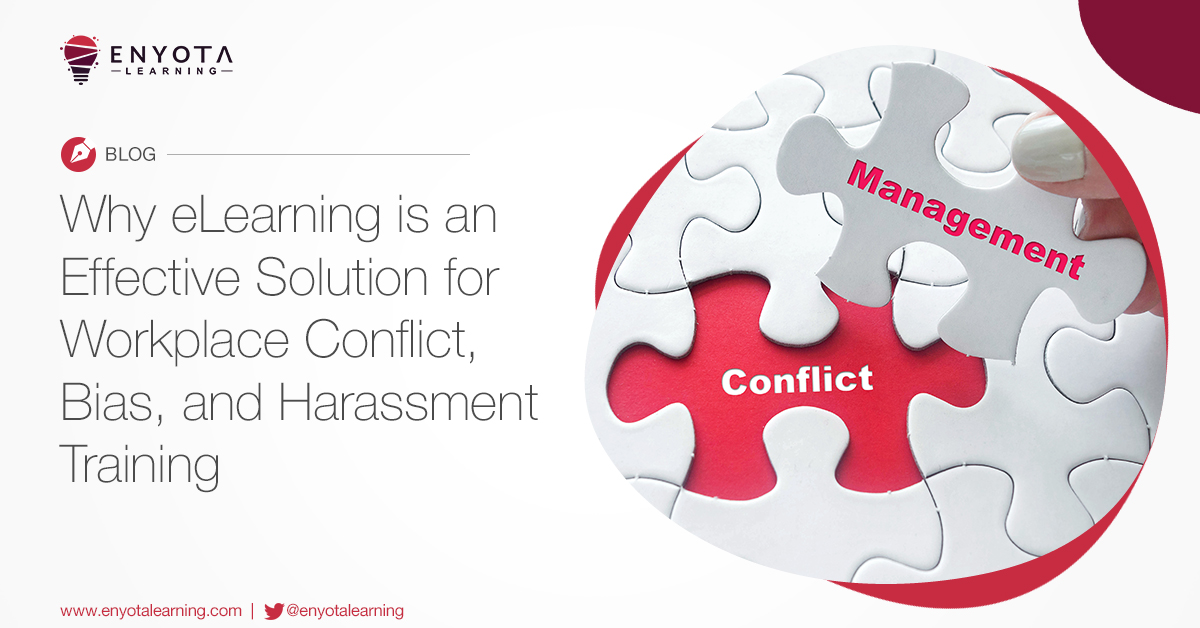Workplace conflict and harassment or even bias between employees can affect the bottom line of an organization even without anyone knowing. For example: an employee resents the workplace because of a sour relationship with a colleague or even the entire team. And, nobody but the people involved and victim know about it.
Sometimes workplace conflicts arise between customers and company representatives which can tarnish the image of companies who are caught in the midst of the feud for no fault of theirs. Except for one, and that is if they never cared to train employees on how and why to avoid conflicts of every kind at the workplace.
Let’s take the example of a workplace conflict like discrimination. It can happen anywhere. However, once you identify an instance of it occurring at your workplace, how do you manage it?
Adding to this, workplaces which are planning to reopen may need workplace conflict training more than anyone else. With people returning from isolation after so long, there are many reasons why workplace conflicts may arise.
How to Avoid Workplace Conflicts and Harassment?
eLearning-based training is a great medium to deliver workplace conflict and harassment training!
Managing workplace conflicts by training employees and creating awareness is how you correctly approach this situation. The inability to manage workplace conflicts with the appropriate steps and actions can quickly snowball into a larger confrontation, especially in the age of social media.
How to Manage Workplace Conflicts with eLearning?
Well, build training to increase your employee’s awareness about the fact that people around them including themselves may feel the urge to get irritated or act irrationally, we call this ‘triggers.’ The solution to this is for employees to identify these ‘triggers’ and quickly stop all further actions in that direction. eLearning-based training can definitely help employees become more self aware.
Ok let’s look at how organizations plan a rough layout for an eLearning course which revolves around training employees on anti-discrimination and racial bias training.
| Module | Format |
|---|---|
| Why Say No to Discrimination and Disputes and Why Disputes May Arise at the Workplace In the Midst of Return-to-Work. |
3-minute video on your company’s stand with regards to discrimination. Which includes why people may feel the urge to act irrationally – this is because of people returning from isolation. |
| The Policy | Simple Level 2 eLearning courses covering the policy explanation, with regards to the actions that your organization may take against people who do commit these mistakes. And how people can report as victims of somebody else’s actions. |
| Scenario-Based Training | 10-minute course which recreates scenarios that employees must avoid indulging in and reporting them. |
| Face-to-Face Confrontation | A blended learning approach where a physical trainer conducts a workshop followed by a monitored Q&A session. |
When it comes to topics like sexual harassment, it is important to determine how such harassment may occur at the workplace. In this case, people may commit such offences via physical actions, verbal comments, or gestures as well. As this topic is very actions and gestures oriented, it is important to cover the training for such a topic using eLearning that is visual. It helps people quickly understand the message that is being conveyed.
In the example of compliance training amongst bank employees, the violations that are most likely to occur are with respect to data breach, false promises, and not following procedures. As a result, a more assessment-based training works better here. One does not need to translate the occurrences into images and scenarios for employees to understand.
When it comes to interacting with customers, race bias is a prevalent issue. However, you must follow the same approach of assessing the type of violation and its root cause. Once determined, you can proceed to build a course that is either a blend of multiple types of training or choose one definitive type.
Some quick action points for companies to consider when going with eLearning-based training:
- Instead of just making employees read and accept your terms and conditions, use eLearning’s ability to conduct internal assessments. You can then use these assessments to confirm if your learners are understanding the training they are undergoing.
- Use visual elements for when the situations are best explained by images and videos. And text-based assessments for when the training is more policy-based.
- Use assessments along the entire journey. Use them as barriers for employees to successfully crossover in order to move to the next module and eventually complete the course successfully.
- No type of training is a one-time effort. Which is why eLearning is more cost-effective when it comes to choosing between traditional or modern approaches. So, use eLearning to repeatedly train new employees, and as refreshers for employees who already have undergone the training.
Make it mandatory for learners to retake the workplace conflict training after specific, regular intervals. You can do this by setting an expiry date on the original certificates. This way, employees are continuously trained in the policies and procedures specific to your organization.
It starts small, but eventually, regular training and development in your organization is very important. We at eNyota Learning have experience in designing custom-built compliance-based training across a variety of policies. Talk to our team of experts to know how we can help your organization create and implement successful compliance-based training courses that are effective and impactful. Workplace conflict and harassment training can further be delivered on a learning management system to make it more effective. Try our LMS – Abara LMS, it comes with a 30-day free trial!





